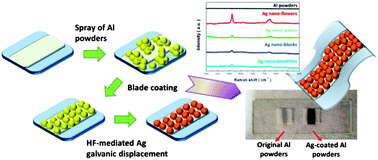Shape-diversified silver nanostructures uniformly covered on aluminium micro-powders as effective SERS substrates†
Abstract
Highly-sensitive, reliable and reproducible Raman-active substrates via a facile and organic-free method are reported. These intriguing hierarchical structures are formed through the uniform incorporation of silver (Ag) nanoflowers with aluminium (Al) micro-supporters. The underlying mechanism is systematically investigated, visualizing that the solvents used in galvanic displacement have a major effect on diversifying the reaction kinetics of Ag deposition. Moreover, the exploration of AgNO3 concentrations reveals a drastic transition of Ag morphologies, driven by the elimination of high-energy surfaces of Ag. In addition, the surface-modified Al@Ag structures with octadecyltrichlorosilane demonstrate both the non-wetting (contact angle = 157.2°), as well as easy droplet roll-off (contact angle hysteresis = 5.4°) characteristics, which further enables the tested targets to avoid being pinned at a static position upon detection. Finally, we find that the Ag nanoflower surfaces are corrugated with numerous nanogaps at interparticle sites, in such a way that allows the abundant active sites (referred to as “hot spots”) to amplify the Raman signal, and simultaneously maintain the sound reliability and reproducibility of Raman detection. These designs along with the fabrication strategy are anticipated to benefit versatile optical, optoelectronic and energy devices.


 Please wait while we load your content...
Please wait while we load your content...